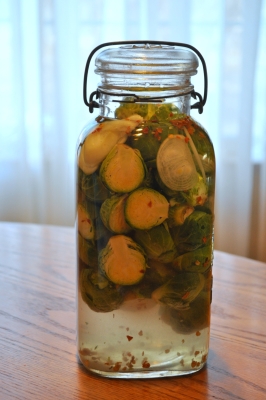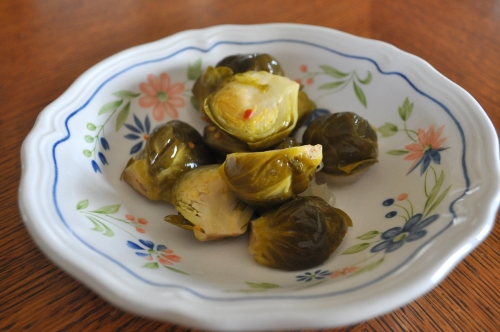FTC Disclosure: Delicious Obsessions may receive comissions from purchases made through links in this article. As an Amazon Associate I earn from qualifying purchases.Read our full terms and conditions here.
Today’s post is from my new friend Melanie Hoffman, author of Pickle Me Too. Melanie and I met at the first of the year, hen I started my 52 Weeks series. She is also one of the newest members of the Nourished Living Network and I am so excited to get to know her better. When I heard about her recipe for lacto-fermented Brussels sprouts, I knew I had to have her share the recipe as week 8 of my series. I have a batch of this working their magic right now and I can’t wait to give them a try. It’s a fantastic twist on your regular cabbage ferments like kimchi or sauerkraut. So, without further adieu, please welcome Melanie to week 8 of some bad a** bacteria!
UPDATE 7/26/12: Neither Melanie nor I use whey as a starter for my ferments (learn why here). We also no longer use Mason jars for my ferments (learn why here). I personally use anaerobic fermenting jars exclusively and the improvement in the taste and texture of my ferments is unbelievable! I encourage everyone to take a look at the information regarding Mason jar ferments and come to a decision that best fits their family. I will be releasing updated versions of these recipes soon, as it applies to these jars. I recommend the anaerobic fermenting systems from The Probiotic Jar.
~~~~~~~~~~~~~~~~~~
Thank you, Jessica, for letting me take over your blog for the day! I was first introduced to Jessica when she announced her 52 Weeks of Bad A** Bacteria series and I knew I had found a friend because I also have a fascination with fermentation. My blog, Pickle Me Too, revolves mainly around cultured foods (though I don’t restrict myself to just fermentation). I feature a ferment each week for Ferment Friday and this is one of the recipes that I created back in December.
At that time, I happened across a bag of organic Brussels Sprouts while on vacation (not something I normally would see in the stores back home) and knew I had to try fermenting them. Closely related to cabbage, they seemed a perfect vegetable to pickle. The best part about these, besides the awesome taste, is how cool they look in the jar.
 Brine Pickled Brussels Sprouts
Brine Pickled Brussels Sprouts
makes approx. 1 quart
- 1lb Brussels Sprouts, rinsed and halved
- 2 shallots, sliced thin
- 1 tsp. red pepper flakes, optional
- 1/4 cup fresh whey
- 3.6% salt brine (4 tbsp. salt dissolved in 8 cups of filtered water)
Layer the Brussels sprouts, shallots, and red pepper flakes in 1 quart mason jar, packing them tight. Pour whey or vegetable culture over the top and fill with salt brine to cover, leaving about 1” of head space. Use a small plate or cabbage leaf to keep Brussels sprouts submerged. Let set at room temperature for one to two weeks. Place in cold storage. Beware when opening the jar. This smells almost as good as kimchi.
 Melanie is the creator and author of Pickle Me Too, a real foods blog that focuses on lacto-fermented foods. She is a homeschooling mom to 4 active boys, living life on a small hobby farm with 32 chickens, 1 cow, 2 goats, and 2 mouse hunting kittens. Her family follows the principles of the WAPF, with some modifications that include limiting grain consumption and avoiding gluten. She is one of the newest members of the Nourished Living Network and is excited to share her knowledge with her fellow bloggers and readers. You can keep up with her through her blog, or connect with her on Facebook or Pinterest.
Melanie is the creator and author of Pickle Me Too, a real foods blog that focuses on lacto-fermented foods. She is a homeschooling mom to 4 active boys, living life on a small hobby farm with 32 chickens, 1 cow, 2 goats, and 2 mouse hunting kittens. Her family follows the principles of the WAPF, with some modifications that include limiting grain consumption and avoiding gluten. She is one of the newest members of the Nourished Living Network and is excited to share her knowledge with her fellow bloggers and readers. You can keep up with her through her blog, or connect with her on Facebook or Pinterest.


17 Comments